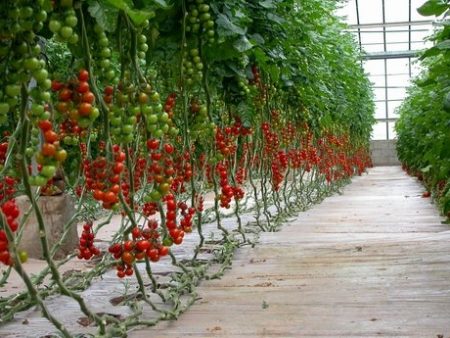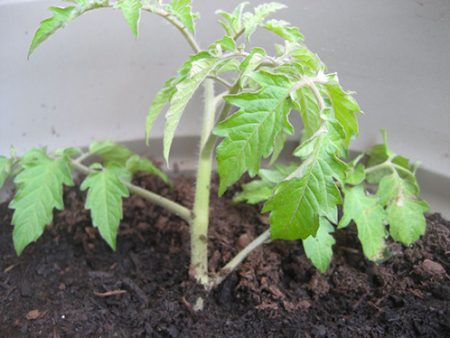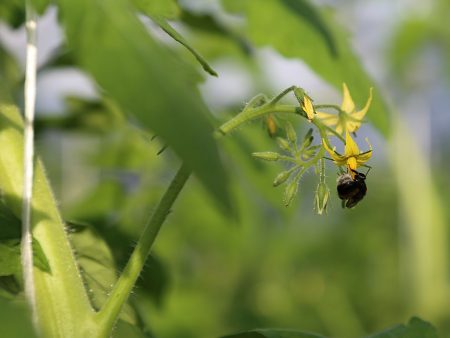 Caring for tomatoes after planting in the greenhouse has its own secrets, which we will tell you about. The difference lies in the special microclimate that exists in the greenhouse, so these nuances must be charmingly taken into account, if you are going to get a good harvest from your plantings, and delight the family with delicious bright fruits, and for the winter harvest for the future for households.
Caring for tomatoes after planting in the greenhouse has its own secrets, which we will tell you about. The difference lies in the special microclimate that exists in the greenhouse, so these nuances must be charmingly taken into account, if you are going to get a good harvest from your plantings, and delight the family with delicious bright fruits, and for the winter harvest for the future for households.
See also - a garden for a bummer who does not dig up all the secrets.
Growing conditions for greenhouse tomatoes
The greenhouse, of course, creates the most suitable conditions for obtaining the crop, but - its microclimate is also favorable for all sorts of pathogenic bacteria, which also like this environment. Therefore, we will be vigilant and observe the conditions.
The first is to observe the crop rotation. If tomatoes were grown last year, plant cucumbers and vice versa. At least at least some crop rotation will be observed.
If the greenhouse is spacious enough - you can grow several types of vegetables that get along well with each other - tomatoes, eggplant and pepper are pretty friendly to each other, they can be grown together. There is already no friendship with cucumbers, therefore it is better not to combine them with tomatoes.
Airing is an important condition. Make a few windows, periodically on similar days, lift the film, tomatoes like airing, moisture stagnation is harmful to them, and they are not at all afraid of drafts. They are afraid only of frost and excessive humidity, which leads directly to late blight.
Soil preparation is the most important condition. Begin to prepare it 10 days before the start of planting seedlings. Remove the topsoil, spill it with potassium permanganate, in order to disinfect from previous plants with their diseases.
Good soil, adequate lighting, moderate moisture with the right fertilizing - the key to a good harvest.
If at the same time you decided to plant potatoes, you will be interested: growing potatoes wisely without weeding and hilling.
When to plant seedlings

In the southern regions in May, seedlings can be transferred to greenhouses. In the north, where the summer is short - start a month or two earlier, so that the tomatoes have time to ripen before the cold. If you grow seedlings yourself - remember, for early varieties, plant seedlings at the end of March, for medium ones, early March is best suited, for late ones - February.
Warm the soil, covering it with a black film, or spill it before planting with hot water. Cold soil will not allow the roots to develop well, they can rot, and normal fruits will not wait. It is also not recommended to plant plants deeply, because the root will begin to give lateral shoots and the plant will stop developing.
When feeding, avoid the large amount of nitrogen that drives the tops, instead of throwing all your strength into developing the fruit.
Planting tomato seedlings
When you transfer the seedlings to a new place of residence, do not touch them for the first week, let them take root, and then start watering and feeding. Until the plants bloom, water once every 5 days, 1 bucket of water per 2 sq.m. enough. How to bloom - increase watering to 2 buckets in such an area. It is better to water early in the morning than in the evening. So you will avoid condensation, which will settle on the foliage, which is harmful to plants. After 2 hours, open and ventilate the greenhouse.
After a week, as you carry out the first watering, start also the garter of the plants. Watch for unnecessary stepsons, break them off in time, so as not to thicken the bush.It is better to pinch in the morning, then by evening the wounds after the injury will heal, and this will not harm the plant.
After 2 weeks, the first top dressing is needed. A half-liter jar of mullein and a spoon of nitrophoska on a bucket of water will be just right, carefully pour a liter of this useful slurry under each plant. After 10 days, repeat top dressing with this composition: add a spoonful of Fertility fertilizer to a bucket of water, combining it with a teaspoon of potassium sulfate. Two more similar top dressings for the season - and your tomatoes, subject to other conditions, will grow to your joy and delight you with a plentiful harvest.
Pollination of tomatoes

The greenhouse must necessarily open on fine days, not only for ventilation, but also for bees, without which pollination will not occur, and all your efforts will not give a result. If the bees do not want to fly to the greenhouse plants - you can hang a jar of sweet water, honey or jam at the entrance. Bees will fly for sweets and at the same time will be engaged in pollination of your tomatoes. To increase the ovaries, spray the plants with 10% solution of boric acid, not only on the leaves, but also on the flowers. Pollination can also be helped by shaking the bushes slightly, then spraying them with water to adhere pollen, and open the greenhouse for ventilation.
Adhering to these tips, you are sure to get a great harvest. Good luck!
See also - tomatoes in a polycarbonate greenhouse planting and care.




 Low-growing tomatoes, without pinching: 5 of the most delicious varieties
Low-growing tomatoes, without pinching: 5 of the most delicious varieties Why tomato seedlings grow poorly
Why tomato seedlings grow poorly We grow a tomato in a shell
We grow a tomato in a shell Growing tomatoes without watering according to the method of Kazarin
Growing tomatoes without watering according to the method of Kazarin